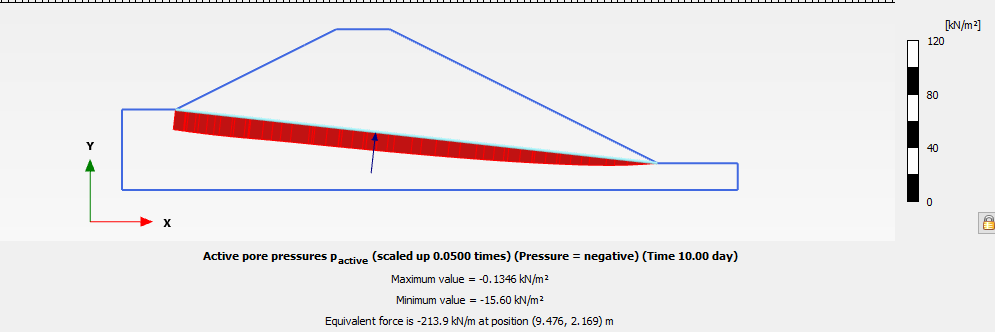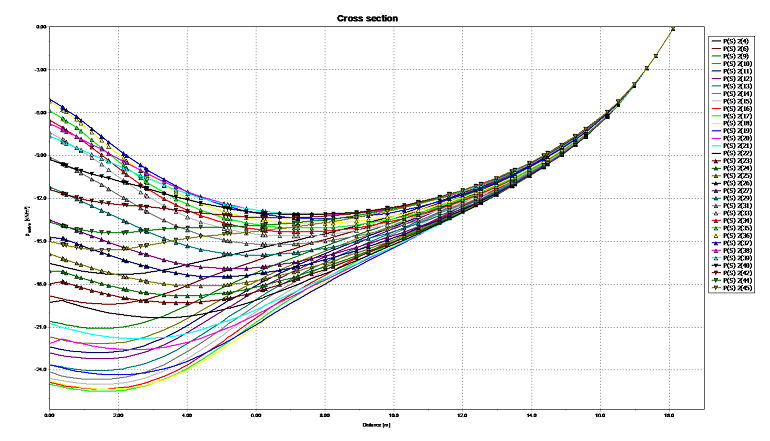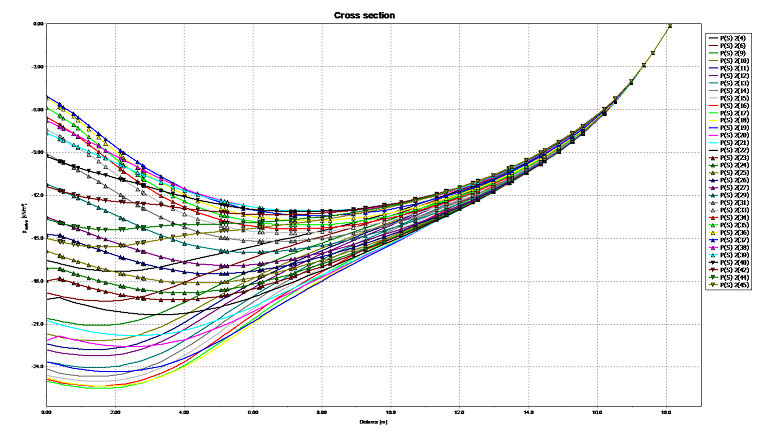

Numerical simulation was carried out on a 6 m high embankment and crest width of 2 m composed of four different type of soils varying in their particle size: silty clay, silty soil, gravelly sand and clay, to conclude their suitability to be used as construction material for embankment. Harmonic flow functions and transient groundwater flow conditions were employed in the PLAXIS simulation. Cross section curves through points (2.0, 3.0) and (20.0, 1.0) showed a drastic variation in the active pore pressure in the case of fine grained particles and a smooth trend in coarser particles such as gravel at the end of staged construction. Not much difference was observed in the ranges of minimum and maximum active pore pressures: -15.6 kN/m2 to -0.1346 kN/m2 respectively, indicating that granular soils are slightly more desirable to be used as construction material for embankment when flow needs to be carried out through it as compared to finer grained particles which can be employed to control flow.
INTRODUCTION
An embankment refers to a structure composed of volumes of earthen material compacted to construct railways or roadways above the existing ground surface level. Similarly embankment dams are constructed for the purpose of storing water. Research has been done to study the suitability of materials to be employed in the construction of embankments and embankment dams. Hosseini studied the effect of simultaneous construction and impounding on the pore pressure development in the earth dams core and observed that filling height and simultaneous impoundment increases pore pressures in the upstream zone and remains unchanged in central and downstream zones. Tafti et al. studied the influence of clay core composition in embankment dams. They used composite clay and pure clay in their research and concluded that high shear strain and high pore pressure developed which decreased undrained shear strength and increased permanent displacement when composite clay was used. Santos et al. analysed different materials to be used as core materials in zoned dams. Their study determined that flow and erosion characteristics within a dam are strongly influenced by grading and compaction characteristics of upstream soils and the crucial parameters being the fines and gravel content, nature of fines (plastic or non-plastic) and compaction water content. The finer the soil higher is its capability to limit flow. Stark et al. studied the hydraulic conductivity and compressibility parameters to evaluate the pore water pressures and concluded that unsaturated and transient seepage analysis should be carried out for estimation of pore pressures and phreatic surface progression through fine grained core. Rios et al. carried out a probabilistic approach to study the stability of dam under rapid drawdown conditions. Though clay being the least permeable materials and having high pore pressure variations, they don’t critically affect the stability of dam during rapid drawdown when used as a thin core and the rock fill properties such as friction angle and permeability greatly influence the factor of safety. Pardoen and Konrad (2019) carried out a numerical study to observe the effect of granular interfaces on the behaviour of zoned embankment dams. Granular soils with low shear resistance at interface had increased relative displacements, settlements and shear strains in the dam.
NOTATIONS
MC: Mohr-Coulomb model
E: Young’s modulus (kN/m2)
ϒunsat: Unsaturated unit weight (kN/m3)
ϒsat: Saturated unit weight (kN/m3)
C: Cohesion (kN/m2)
Φ: Friction angle
υ: Poisson’s ratio
Rinter: Interface strength parameter
kx: Horizontal permeability (m/day)
ky: Vertical permeability (m/day)
NUMERICAL SIMULATION
In this paper, a comparative study is carried out to observe the flow patterns through an embankment constructed of different types of soils, varying in their properties and particle size, using a commercially available finite element PLAXIS-2D software. In order to carry out the simulation, 4 types of soils are selected, i.e. silty clay, silty soil, gravelly sand and clay.
The simulation consisted of a 6 m high embankment and 2 m crest width. The water head was specified as 4.5 m. The simulation contours were set as: xmin = 0.0 m, xmax = 23.0 m, ymin = 0.0 m and ymax = 6.0 m. A 2-dimensional plane strain model with 15- node elements was selected to carry out the study. For all the types of soils included in this study, Mohr Coulomb failure criterion was used in the modelling. The properties of the soils used are as listed in Table 2.
The model was fine meshed and the coarseness factor of the upstream side was changed to 0.5. ‘Flow only’ calculation type was selected to carry out the flow analysis in the embankment in the 4 simulations. Harmonic flow function was used to describe the variation of head and discharge with time. In PLAXIS, harmonic flow function is defined as:
y (t) = yo +A sin (ωot + ϕo), where
A: amplitude (in unit of length)
ϕo: initial phase angle
T: wave period (in unit of time)
yo: center of harmonic variation
Cross section curves were drawn through (2.0, 3.0) and (20.0, 1.0) to study the harmonic variation of results at different time intervals in different phases of staged construction.


Table 1: Model geometry information
| Borehole number | Location (m) | Head (m) | Top level (m) | Bottom level (m) |
| 1 | 2.0 | 4.5 | 3.0 | 0.0 |
| 2 | 8.0 | 4.5 | 6.0 | 0.0 |
| 3 | 10.0 | 4.0 | 6.0 | 0.0 |
| 4 | 20.0 | 1.0 | 1.0 | 0.0 |
Table 2: Parameters considered in the simulation (Zhang et al. (2015)
| Soil Type | Silty clay | Silty soil | Gravelly sand | Clay |
| Model | MC | MC | MC | MC |
| Drainage Type | Drained | Drained | Drained | Drained |
| E (kN/m2) | 5.2E3 | 7.6E3 | 30E3 | 22.1E3 |
| ϒunsat (kN/m3) | 17.2 | 17.8 | 20.1 | 18.3 |
| ϒsat (kN/m3) | 17.2 | 17.8 | 20.1 | 18.3 |
| C (kN/m2) | 14.2 | 7.6 | 0 | 15.7 |
| ϕ | 16.3 | 19.7 | 28.6 | 21.0 |
| υ | 0.33 | 0.33 | 0.30 | 0.30 |
| Rinter | 0.65 | 0.65 | 0.65 | 0.80 |
| kx (m/day) (default) | 0.02272 | 0.02272 | 0.02272 | 0.02272 |
| ky (m/day) (default) | 0.02272 | 0.02272 | 0.02272 | 0.02272 |
RESULTS AND DISCUSSION
Simulation 1: Flow through an embankment composed of silty clay.



Fig 4: cross-section curves showing variation of pactive (kN/m2) with distance (m) at the end of phases in silty clay embankment.
Simulation 2: Flow analysis of an embankment constructed using silty soil.



Fig 6: cross-section curves showing variation of pactive (kN/m2) with distance (m) at the end of phases in embankment composed of silty soil.
Simulation 3: Numerical simulation of an embankment made of gravelly sand to carry out flow analysis.



Fig 8: cross-section curves showing variation of pactive (kN/m2) with distance (m) at the end of phases in embankment composed of gravelly sand.
Simulation 4: Flow through an embankment composed of clay.



Fig 10: cross-section curves showing variation of pactive (kN/m2) with distance (m) at the end of phases in embankment composed of clay.
As inferred from figures 4 and 9, when fine grained soils such as silty clay and clay were used as construction material for embankment, the active pore pressure, comprising the total stress in pores of the soil, varied from -15.6 kN/m2 to -0.1346 kN/m2 (Fig 3and 9). Comparing the cross section curves in Fig 4, it can be concluded that pactive showed a drastic increase at the end of phase 2, inferring that slower variation of external water level had great influence on active pore pressures in the embankment over large distances.
Whereas for coarse soil particles, such as silty soil and gravelly sand, having comparatively larger particle size than fine grained soils, the active pore pressures varied from -15.62 kN/m2 to -0.1346 kN/m2 (Fig 5 and 7). The trend of active pore pressure cross section curves also showed a smooth trend at the end of the 2 construction phases (Fig 6 and 8), concluding a gradual variation of active pore water pressure over the length of embankment.
The results from this study can be correlated with the physical and mechanical properties of the soils. Coarse grained soils such as gravels and sands have particle size ranging from 4.75mm to 80 mm and 0.075 mm to 4.75 mm respectively. Due to their large particle size, surface roughness and rotund shape pertains in these types of soils thereby decreasing their surface area. On the other hand, the particle size varies from 0.002 mm to 0.075 mm for silts and less than 0.002 mm for clays. Therefore they have large specific areas pertaining due to their finer sized particles thereby holding the clay particles tightly with very little or no airspace. This explains the water holding property of the clay particles which is employed for limiting flow in embankments.
Permeability in soils depends on average pore size which is governed by the particle size distribution, particle shape and soil structure. Due to large particle size, irregular shapes and higher number of voids, coarse grained particles such as sands and gravels have comparatively higher permeability ranging between 10-3 cm/sec and 100 cm/sec as compared to 10-7 cm/sec to 10-9 cm/sec in finer sized soil particles. This describes the suitability of coarse grained soil to be employed in embankment construction where flow is required to take place.
CONCLUSION
This paper presented a flow study through an embankment composed of 4 different soils: silty clay, silty soil, gravelly sand and clay, to compare their suitability to be used as construction material for embankments. The results of the study can be summarised as:
- Coarse grained soils, i.e. silty soil and gravelly sand, showed a gradual variation of pore water pressures through a selected embankment cross section in all the construction phases as compared to that of fine grained soils. This can be attributed to the larger particle size of coarse grained soils in comparison to that of fine grained soils.
- There was not much difference in the range of active pore water pressures for all the types of the soils used in the simulation. Clayey sand tends to give higher pore pressure as compared to lean silt.
- Therefore, it can be concluded that granular soils such as gravel are more desirable to be employed in the construction of embankment when flow is required to take place and finer sized particles can be employed to restrain water flow in the embankment.
REFERENCES
- Hosseini, S.M. “Pore pressure development in the core of earth dams during simultaneous construction and impounding.” Electronic Journal of Geotechnical Engineering.
- Pardoen, B. and Konrad, J.M.“Numerical modeling of zoned rock fill dam during construction considering granular interface behavior.” ASCE Journal of Geotechnical and Geo-environmental Engineering 145(3).
- Rios, A.C., Porfirio, M. and Assis, A. “A probabilistic approach to the stability of a dam under rapid drawdown conditions.” ASCE Journal of Geotechnical and Geo-environmental Engineering, 115-123.
- Santos, R.N., Caldeira, L.M and Neves, E.M. “Factors limiting the progression of internal erosion in zoned dams: Flow limiting by an upstream material.” ASCE Journal of Geotechnical and Geo-environmental Engineering,
- Stark, T.D., Jafari, N.H., Zhindon, J.S and Baghdady, A.. “Unsaturated and transient seepage analysis of San Luis Dam.” ASCE Journal of Geotechnical and Geo-environmental Engineering,
- Tafti, S.R., Shafiee, A. and Rajabi, A.. “The influence of clay core composition on the permanent displacement of embankment dams.” 14th World Conference on Earthquake Engineering.
- Zhang, J., Liu, S., and Pu, H. . “Evaluation of an improved technique for geosynthetic reinforced and pile supported embankment.” Advances in Materials Science and Engineering

